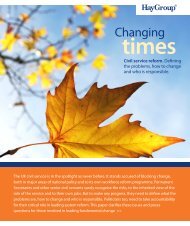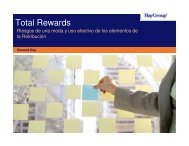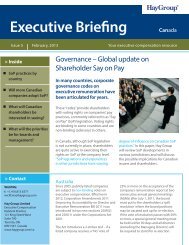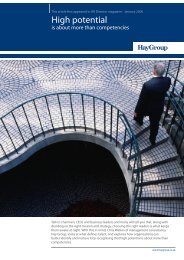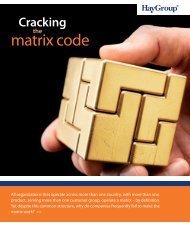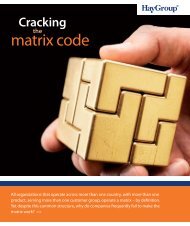Engage Employees and Boost Performance - Hay Group
Engage Employees and Boost Performance - Hay Group
Engage Employees and Boost Performance - Hay Group
Create successful ePaper yourself
Turn your PDF publications into a flip-book with our unique Google optimized e-Paper software.
If companies don’t manage the<br />
message about employee pay,<br />
employees will do so on their<br />
own, distorting the truth <strong>and</strong><br />
needlessly undermining morale.<br />
24<br />
W O R K I N G<br />
PAPER<br />
Second, the U.K. example shows that if companies don’t manage the message<br />
about employee pay, employees will do so on their own, distorting the truth<br />
<strong>and</strong> needlessly undermining morale.<br />
GDDS made sure this didn’t happen. When the company created a pay-for-performance<br />
program in 2000, it went to great lengths to make sure employees<br />
understood it <strong>and</strong> were convinced it was fair. For example, GDDS educated<br />
employees extensively, running articles in the company newsletter explaining<br />
the details of the plan. It also conveyed data to employees showing that the<br />
“bonus pool,” which equaled six percent of payroll, matched software industry<br />
averages <strong>and</strong> exceeded norms in the aerospace/electronics sector by 1.5 percent.<br />
Finally, GDDS educated managers on the importance of explaining why<br />
their people earn what they earn. “You’ve got to be able to tell a good performer,‘I’m<br />
giving you a 20 percent increase <strong>and</strong> here’s why,’” says Lipa.<br />
“You’ve got to reinforce what he did right. And of course you have to do the<br />
same for the guy who gets 3 percent. It’s only fair to him that he get an explanation<br />
of what he needs to do differently.”<br />
Create a culture of recognition<br />
Managers everywhere dramatically underestimate the power of spot recognition<br />
— for example, simply complimenting employees on their work. Or giving<br />
employees gifts — dinner for two, tickets to a play or a sporting event — if<br />
they complete a project on time <strong>and</strong> within budget. The benefit is huge. The<br />
cost is small.<br />
In the 2001 Managerial Styles survey at GDDS (see Figure 5), the score for the<br />
Affiliative style rose more than any other (from 37 to 70) as a result of the<br />
change efforts that began in 2000. This indicated that during a year of intense<br />
management development, the senior staff made huge gains in its ability to<br />
encourage employees through positive feedback.<br />
Director of Accounting <strong>and</strong> Taxes Bill Craig recently worked on a task force<br />
that assembled a report analyzing overhead rates for a new IT program. When<br />
the group presented the report, a senior staff member expressed dismay; the<br />
program wasn’t feasible with such high overhead. But the senior staff member<br />
told Craig in private that the report was well done.“He recognized the<br />
effort that went into it,” says Craig. “That meant more to me than money.”







